Important changes to right to work checks from 1 October
British businesses are being urged to prepare for changes to the rules around right to work checks due to be implemented from 1 October 2022.
A recent poll by Xydus showed that almost half (48%) of businesses surveyed were unprepared for the upcoming changes and more than three-quarters (78%) were unaware that failing to carry out the correct right to work checks on their employees could result in imprisonment.
At the beginning of the COVID-19 pandemic in March 2020, the Home Office introduced temporary concessions to allow employers to carry out remote right to work checks whilst businesses were being advised to allow their staff to work from home where possible. The adjustments allow employers to carry out right to work checks over video calls, and permit job applicants and existing workers to send scanned documents or a photo of documents for checks rather than sending originals.
However, the modified scheme is set to end on 30 September 2022. This means that from 1 October, employers will need to either:
- Perform an in-person manual check using original documents
- Perform an online check using the Home Office online service
- Engage the services of a certified Identity Service Provider (IDSP).
The changes present significant challenges for some businesses, such as those operating with fully remote workforces. Although retrospective checks are not required for those employees who had a COVID-19 adjusted check between 30 March 2020 and 30 September 2022 (inclusive), employers will need to ensure processes are in place to comply with the rules when the concessions end.
Below, we set out how to perform each type of right to work check, what could happen if you fail to comply, and where to get help.
Manual right to work checks
A manual right to work check can be conducted by following these three steps:
- Ask to see the applicant’s original documents
- Check that the documents are valid with the applicant present
- Make and keep copies of the documents and record the date you made the check.
A list of acceptable documents for manual right to work checks can be found here.
Since 6 April 2022, the way in which Biometric Residence Card (BRC), Biometric Residence Permit (BRP) and Frontier Worker Permit (FWP) holders evidence their right to work has changed. Employers can no longer accept physical cards for the purposes of a right to work check, and must instead use the Home Office online service.
Online right to work checks
To conduct an online right to work check, you will need the applicant’s date of birth and their share code, which they can obtain online here. An online check can then be carried out by following these three steps:
- Use the Home Office online right to work checking service by visiting https://www.gov.uk/view-right-to-work
- In the presence of the individual, satisfy yourself that any photograph on the online right to work check is of the individual presenting themselves for work.
- Retain and securely store a clear copy of the response provided by the online right to work check.
The Home Office right to work online service is free to use and gives employers a defence against a civil penalty. You don’t need to see or check the individual’s documents, as right to work information is provided in real time directly from Home Office systems.
Using an Identity Service Provider (IDSP)
Since 6 April 2022, employers have had the option to make use of new Identity Document Validation Technology (IDVT) via the services of a certified Identity Service Provider (IDSP) to complete the digital identity verification element of right to work checks for British and Irish citizens who hold a valid passport (including Irish passport cards).
Basic steps for conducting a right to work check using an IDSP are as follows:
- IDSPs can carry out digital identity verification to a range of standards or levels of confidence. The Home Office recommends that employers only accept checks via an IDSP that satisfy a minimum of a Medium Level of Confidence.
- Satisfy yourself that the photograph and biographic details on the output from the IDVT check are consistent with the individual presenting themselves for work.
- Retain a clear copy of the IDVT identity check output for the duration of employment and for two years after the employment has come to an end.
Employers using this new service should be aware that despite engaging the services of an IDSP to carry out the necessary checks, the employer remains responsible for ensuring the IDSP is carrying out the check correctly. You will only have a statutory excuse if you reasonably believe that the IDSP has carried out their checks in accordance with the Home Office guidance.
A list of certified IDSPs can be found here.
Consequences of non-compliance
All employers are required by law to carry out right to work checks on their employees, in order to prevent illegal working. It is an offence to knowingly employ anyone who does not have the right to work in the UK. Carrying out compliant right to work checks on your employees provides your business with a statutory excuse and protects you against liability for a civil penalty if that person is later found to be working for you illegally.
Employers can face a civil penalty of up to £20,000 for each illegally employed worker who does not have the right to work in the UK, and where correct right to work checks were not undertaken. Businesses could also lose the ability to sponsor foreign nationals on work visas and even face criminal convictions if they do not comply with the new guidelines.
Help with conducting compliant right to work checks
You can find out more information about right to work checks in the Home Office guidance for employers. You can also contact the Home Office employer enquiry helpline on 0300 790 6268.
Alternatively, Smith Stone Walters is on hand to provide advice and support to employers in remaining compliant with the immigration rules and preventing illegal working. To find out how we can help, please contact us today.










